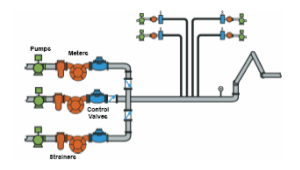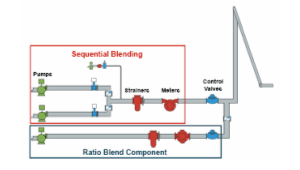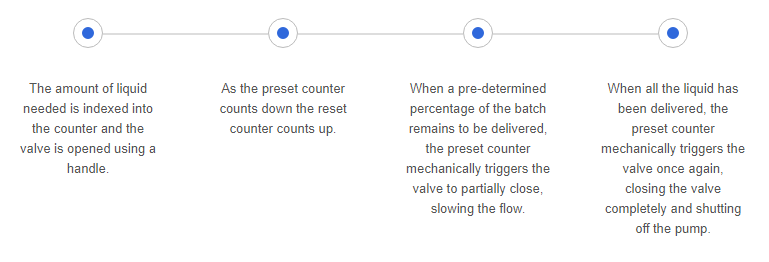BLENDINGFranklen Equipment and our partners bring experience and expertise to any number of blending applications... Read More |
TRUCK & RAIL LOAD/UNLOADFranklen Equipment is a provider of total solutions for customers needing to transfer or store liquids in bulk... Read More |
BATCHINGA batching system is an economical way to add liquids in a precise amount. There are two basic types; mechanical and electronic... Read More |
BLENDING
Franklen Equipment and our partners bring experience and expertise to any number of blending applications. We can provide skid built units or individual components to support batch or sequential blending, ratio controlled blends or wild stream operations.
Systems can be manual, microprocessor-controlled or PLC-based depending on your application.
Typical applications:
ethanol blending > bio-diesel > oil and fuel blending > bio lubes > chemical dilution > asphalt blending
| Sequential Blending | Ratio Blending |
 |
 |
| Loading of two or more products into a compartment through one meter and control valve and one loading arm by selecting individual products in a specified sequence by opening and closing dedicated product block valves. | Loading of two or more products into a compartment simultaneously where each product has its own set of dedicated meters and control valves. |
| Hybrid Blending | Side Stream Blending (wild stream) |
 |
 |
| A combination of ratio blending a component into a sequential recipe, such that the ratio component is blended each time a sequential component is selected. | A Two- product ratio blender where the minor of two products is metered and controlled by a valve. The main product is free flowing. Another meter and its corresponding control valve are located downstream from where the two products merge. |
TRUCK & RAIL LOAD/UNLOAD

Franklen Equipment is a provider of total solutions for customers needing to transfer or store liquids in bulk.
We can provide you with complete solutions for truck loading and unloading. From tank truck systems and API couplers to loading arms and safety access equipment, we have solutions for almost every application.
Franklen Equipment can also provide and install a variety of loading arms and gantry access equipment for the top and bottom loading of rail cars. We serve the petroleum, chemical and food industries providing effective loading and unloading systems for the safe and efficient handling of all types of liquid. We work closely with you to design the best system for your application.
Bottom Loading Benefits
SafetySafety of the person operating the loading arm is the prime advantage since the operator remains on the ground, not on top of the vehicle where falls are a common threat. |
SpeedSpeed is a key advantage of terminal tank truck bottom loading, tanks can be filled faster because a number of compartments can be loaded simultaneously. |
Reduced TimeConnections are made more quickly so overall loading time is reduced |
Less TurbulenceBottom loading systems create less turbulence in the tank, reducing the danger of generating static electricity. |
Vapor RecoveryBottom loading systems can be easily adapted to fully recover vapors displaced during loading.
|
Cost-EffectiveBottom loading islands are simpler and cheaper to build than top loading racks. You can realize more savings because you'll safely load more material in a shorter time with less spillage and vapor loss. |
Top Loading
Top Loading railcars and trucks systems should have sufficient horizontal range to reach the farthest compartment without re-spotting the vehicle. Sufficient vertical movement and drop-pipe lengths are also necessary to service vehicles of varying heights. A properly designed top loading system can achieve these requirements.
Top loading can also be used for tight-fill and vapor recovery applications when used with specially designed and engineered components, such as vapor plates, and tapered hatch plugs. Special top loading designs can also be supplied with a wide range of valves, fittings, and instrumentation equipment.
LYNX Series Bottom-Loading Coupler
 LYNX is optimized to bring your liquid terminals and tank trucks the very best in dry-break API technology. From its ultra-durable stainless-steel collar to its ability to protect your loading-arm connection even when facing surge pressures up to 500 psi, you can count on LYNX for years of service and to help minimize fluid loss.
LYNX is optimized to bring your liquid terminals and tank trucks the very best in dry-break API technology. From its ultra-durable stainless-steel collar to its ability to protect your loading-arm connection even when facing surge pressures up to 500 psi, you can count on LYNX for years of service and to help minimize fluid loss.
Fast Disassembly, Less Downtime
If you have 30 seconds and a screwdriver, you can disassemble LYNX. Thanks to a U-pin design, loading-arm operators can perform coupler maintenance without special tools and do it quickly.
BATCHING
A batching system is an economical way to add liquids in a precise amount. There are two basic types; mechanical and electronic.
Mechanical Batching
A mechanical system has a meter with a mechanical preset counter, a reset counter and mechanical preset valve. A micro switch can be wired into the system to start and stop a pump.

Electronic Batching
An electronic batching system has a meter equipped with a pulse transmitter. The pulse transmitter can have a resolution from one pulse per gallon to over a thousand pulses per gallon. The pulse is transmitted to an electronic batching counter. The batching counter factors the pulses into engineering units such as pounds or gallons.

